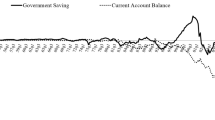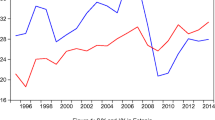Abstract
This paper reviews the saving-investment (S-I) balance in the Hokkaido economy by analyzing hitherto unexamined long-term, time-series data from prefectural accounts in Hokkaido. The S-I balance in Hokkaido consists of the private and government sectors and the balance of regional payments. However, the area economy depends especially on fiscal transfers from the government and on the behavior of the gap between saving and investment that are included in transfers of the central government. Therefore, it is difficult to use the S-I balance before adjusting for three aspects: fiscal, capital, and income transfers. Thus, the transfers are considered to be composed of the balance of regional payments, and the expression for the S-I balance is developed after transfers are adjusted by sectors so that the Hokkaido economy can be examined from the perspective of its money flow. The results are as follows: (1) The fiscal deficit is more than the net export deficit. As a result, the S-I balance in Hokkaido, after adjusting the transfers (or the claims outside Hokkaido), is negative. (2) Private sector savings are excessive, and government sector investments are excessive. Furthermore, the value of the former is less than that of the latter. (3) Excess investment from the government sector has declined over time. Declining net capital transfer and increasing net other current transfers cause the excess investment situation. Net other current transfers are transformed from development-incentive funds to social security service-incentive funds. These results raise questions regarding the classic economic view that savings and investments will always balance over time via market mechanisms. A variety of measures should be taken to address the imbalance and the resulting slow economic growth in Hokkaido, including innovative investment, export-oriented stimulation, enhancement of financial intermediary functions, and compromised financing between the government and the private sectors, such as private finance initiatives.
Similar content being viewed by others
References
Andrew, A. B. and B. S. Bernanke (2005) Macroeconomics, 5th ed., Addison-Wesley, Boston, Mass.
Cabinet Office (2006) Annual Report on Japan’s Economy and Public Finance (in Japanese).
— (2009) Annual Report on Japan’s Economy and Public Finance (in Japanese).
— (2008) Annual Report on National Accounts (in Japanese).
Development Bank of Japan (2000) Review of Industrial History in Hokkaido (in Japanese), Sapporo.
Harvey, A. and J. Taylor (2000) Regional Economics and Policy, Blackwell, Oxford.
Hokkaido Government (2002) Annual Report on the System of Prefectural Accounts in Hokkaido for the 1999 Fiscal Year (in Japanese).
— (2006) Annual Report on the System of Prefectural Accounts in Hokkaido for the 2003 Fiscal Year (in Japanese).
— (2009) Annual Report on the System of Prefectural Accounts in Hokkaido for the 2006 Fiscal Year (in Japanese).
Horie, Y. (2005) Regional Finance and Corporate Revival (in Japanese), Chuo Keizai sha, Tokyo.
Iwasa, Y. (2009) Regional Analysis for Financial System (in Japanese), Chuo Keizai Sha, Tokyo.
Joseph, E. S. and C. E. Walsh (2002) Principles of Macroeconomics, 3rd ed., W. W. Norton, New York.
Kanno, M. (2009) “Economic Conditions and Public Finance in Hokkaido (in Japanese),” University of Chuo, Keizaigaku Ronsou 49: 39–59.
Keynes, J. M. (1937) “Alternative theories of the rate of interest,” Economic Journal, in D. E. Moggrige (ed) (1971) Collected Writings of J. M. Keynes, Vol. XIV, Macmillan for the Royal Economic Society, London.
— (2007) The General Theory of Employment, Interest and Money (with a new introduction by P. Krugman), Palgrave Macmillan for the Royal Economic Society, Basingstoke.
Minegishi, N. (2005) “Economic Structure from the Annual Report on the System of Prefectural Accounts Perspective (in Japanese),” Economic and Financial Condition, pp. 1–22, Tokyo.
Nakamura, Y. (1999) An Introduction to SNA (in Japanese), Nihon Kezai Shinpousha, Tokyo.
Onuma, M. (2002) Industrial History in Hokkaido (in Japanese), Hokkaido University Press, Hokkaido.
Saito, I. (2007) “Saving, Investment, and the Financial System in the Hokkaido Economy (in Japanese),” Shinkin Central Bank Monthly Review 6: 22–37.
Sano, N. (2000) “Regional Financial Dependence (in Japanese),” Regional Policy Research 3: 1–66.
Tanizawa, H. (1999) “Middle- and Long-term Rejuvenation Measures in the Flow of Funds Perspective (in Japanese),” Hokkaido-Tohoku Development Finance Public Corporation, Kihou Hokutou 52: 64–71.
Yasuhara, T. (2003) Stabilizing the Unstable Economy in Mexico (in Japanese), Shinhyoron, Tokyo.
Yamori, N. (1995) “The relationship between domestic savings and investment: The Feldstein-Horioka test using Japanese regional data,” Economics Letters 48: 361–366.
Author information
Authors and Affiliations
Corresponding author
Additional information
T. Kanzaki has a Ph. D. in Economics from Hokkaido University and is currently a research fellow at the Research Group for Regional Studies (RSRG) at Otaru University of Commerce. This paper has been significantly revised, following its presentation at a joint forum of the Association of Evolutionary Economics and Otaru University. No part of this paper may be cited without the author’s permission.
About this article
Cite this article
Kanzaki, T. An Analysis of the Saving and Investment Balance in Hokkaido from the Perspective of Long-term Data. Evolut Inst Econ Rev 9 (Suppl 1), S25–S42 (2012). https://doi.org/10.14441/eier.9.S25
Published:
Issue Date:
DOI: https://doi.org/10.14441/eier.9.S25




